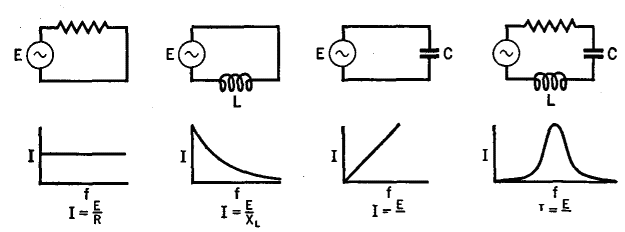| Basic Radio is a free introductory textbook on electronics based on tubes. See the editorial for more information.... |

|

Home  Fundamentals Fundamentals  A.C. Circuits A.C. Circuits  Reactance and Impedance Reactance and Impedance |
|||||||||||||||||||||||||||||||||
| See also: Phase | |||||||||||||||||||||||||||||||||






|
|||||||||||||||||||||||||||||||||
|
Reactance and ImpedanceAuthor: J.B. Hoag
The opposition which a pure inductance (an inductor without resistance or capacitance) offers to the flow of an alternating current is called its inductive reactance and is represented by XL. It will be greater, the greater the inductance L (henries) and the higher the frequency f (cycles per second), and in direct proportion in both cases. Thus XL = 2πfL (ohms). The opposition to the flow of alternating current which is set up by a pure condenser (capacitor without resistance or inductance) is called capacitative reactance and is represented by XL. The greater the capacitance C (farads) and/or the greater the frequency f (cycles per second), the less Xc will be. Thus
The opposing effect of a capacitance and an inductance connected together one after the other (in series) is called the total reactance, X, of the circuit. It is given by: X = XL - Xc (ohms). The inductive reactance is taken as positive. The total opposition to alternating current flow, set up by a pure resistance, inductance, and capacitance in series with each other, is called the impedance of the circuit and is given by
It is to be noted that R and X are not added algebraically but as though they were at right angles to each other. Ohm's law for an a.c. circuit is: E = IZ, as contrasted with E = IR for a d.c. circuit. The currents I (r.m.s. values) which flow under the conditions discussed above are shown graphically in Fig. 5 A, where the frequency of the oscillator is raised from zero (d.c.) to higher and higher values.
Comparative reactances are given in Table 5 A and should be examined carefully by the student.
|
|||||||||||||||||||||||||||||||||
Home  Fundamentals Fundamentals  A.C. Circuits A.C. Circuits  Reactance and Impedance Reactance and Impedance |
|||||||||||||||||||||||||||||||||
Last Update: 2010-11-27




